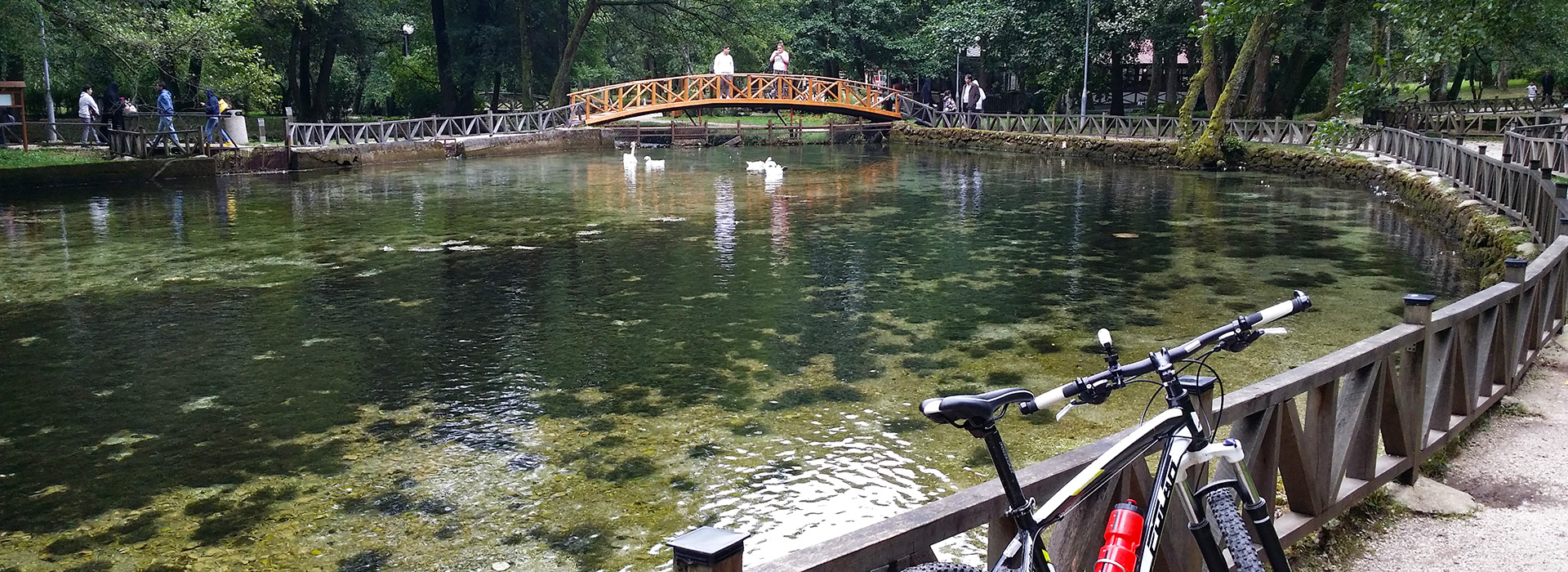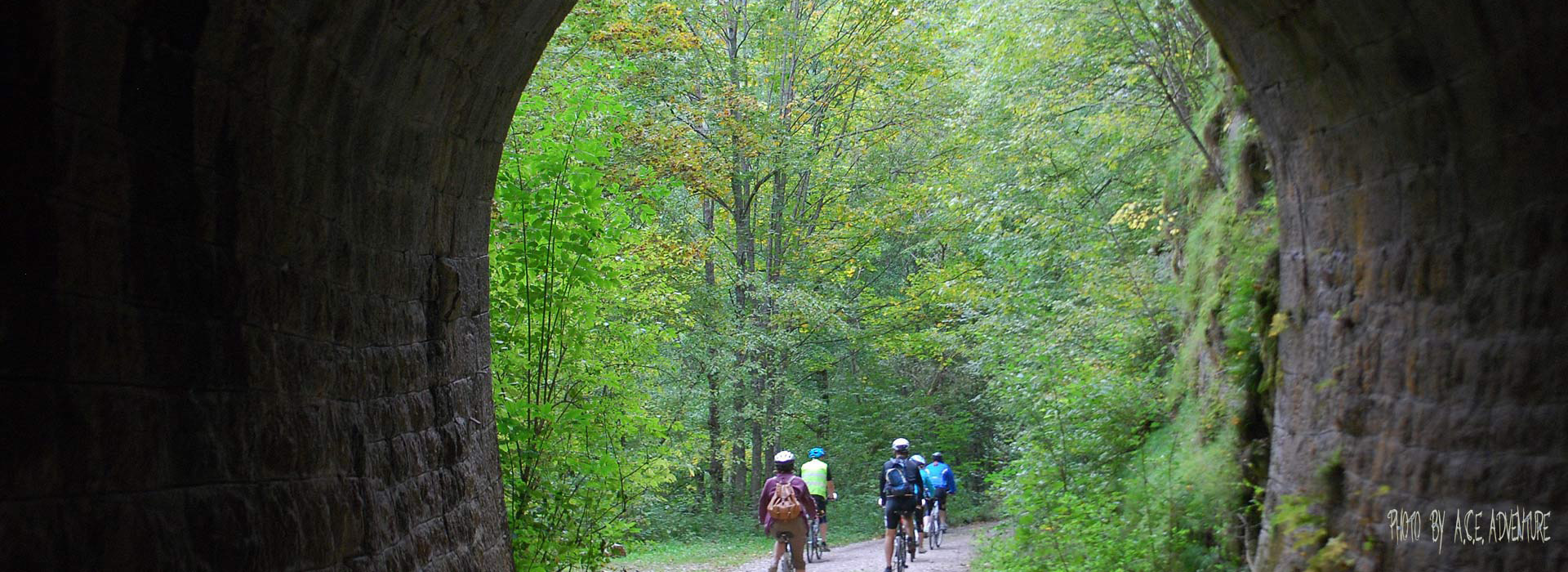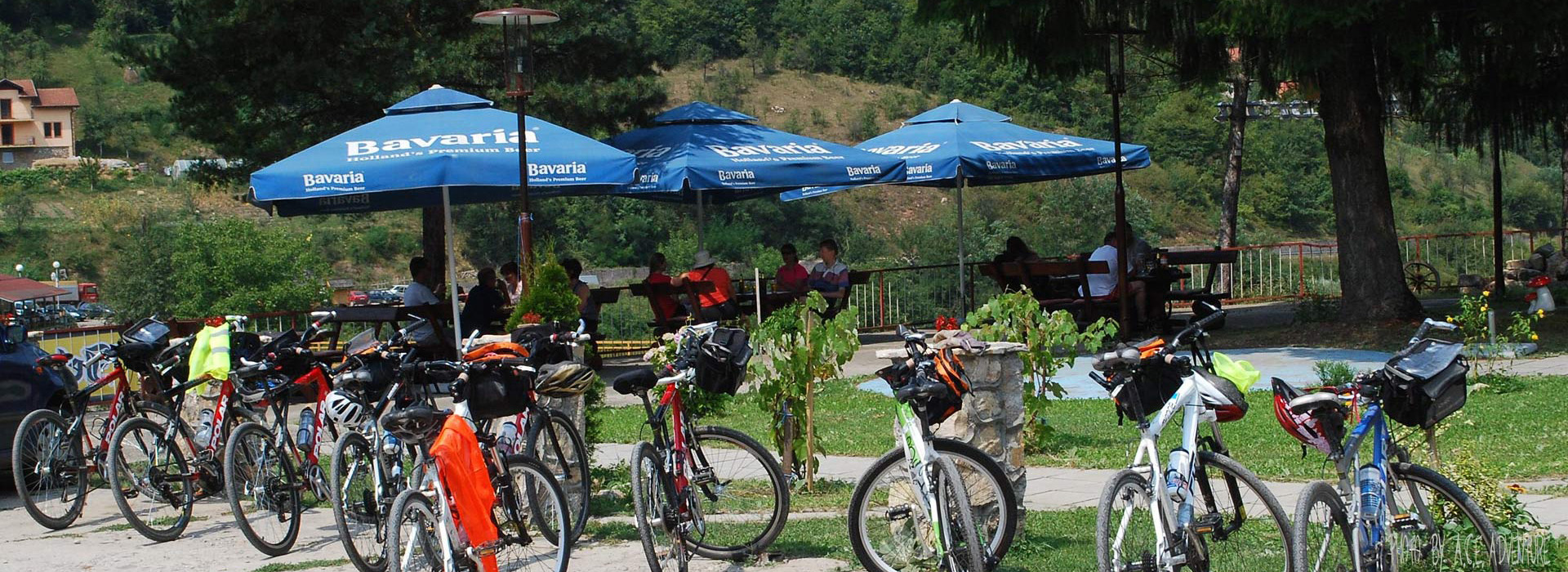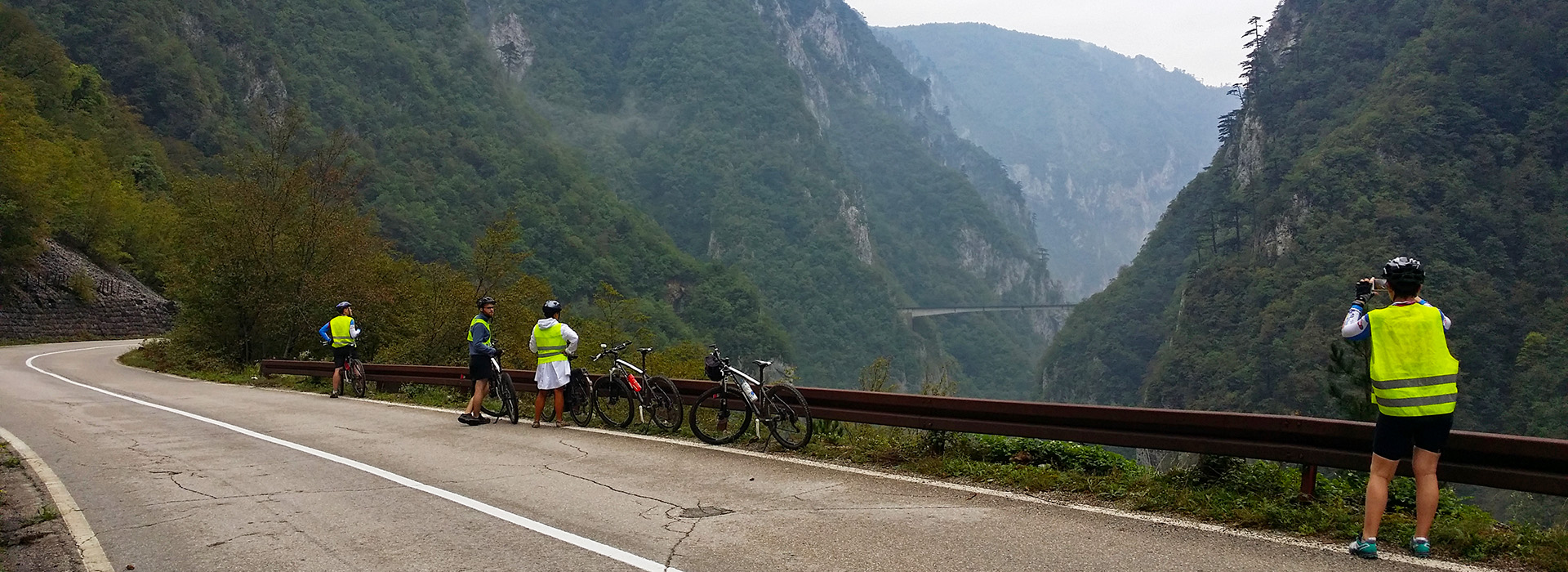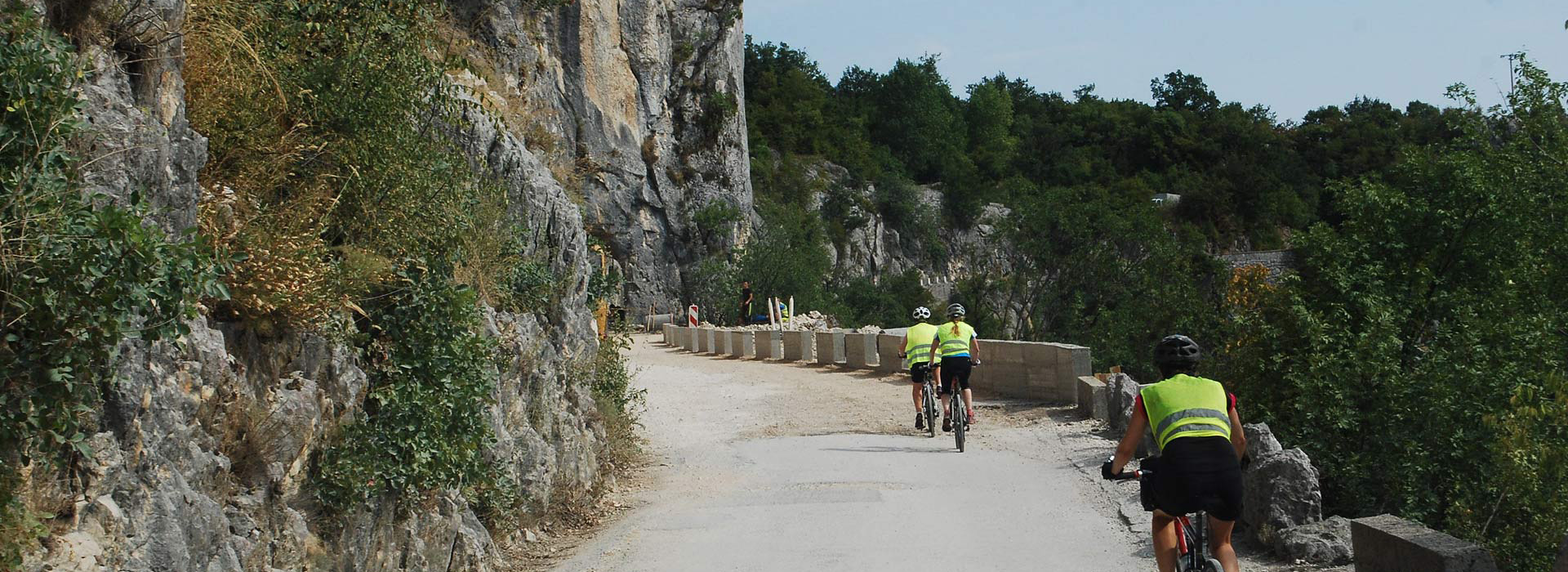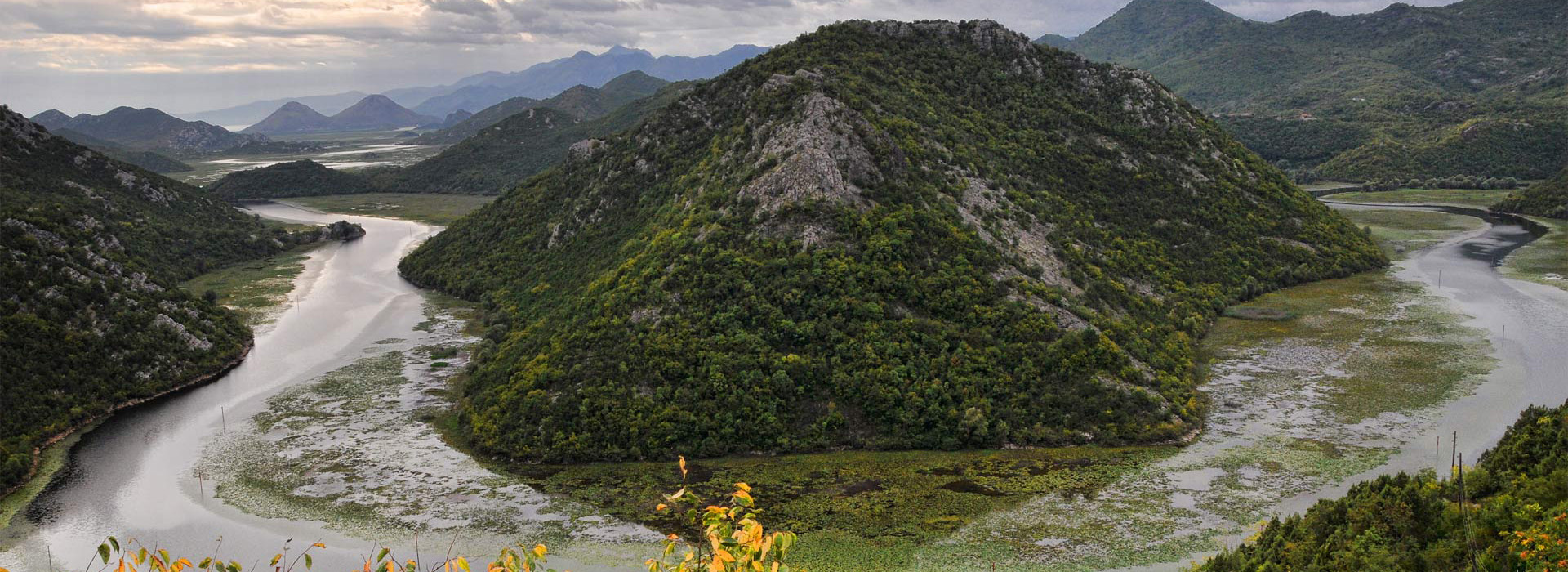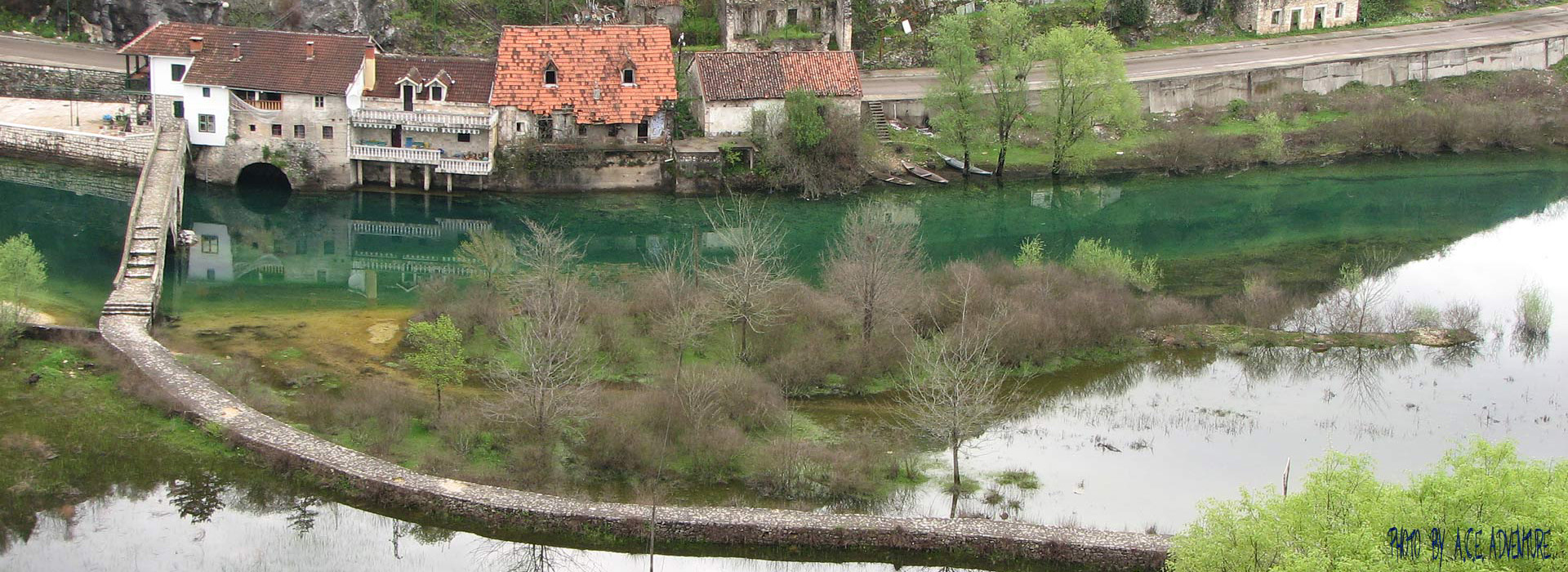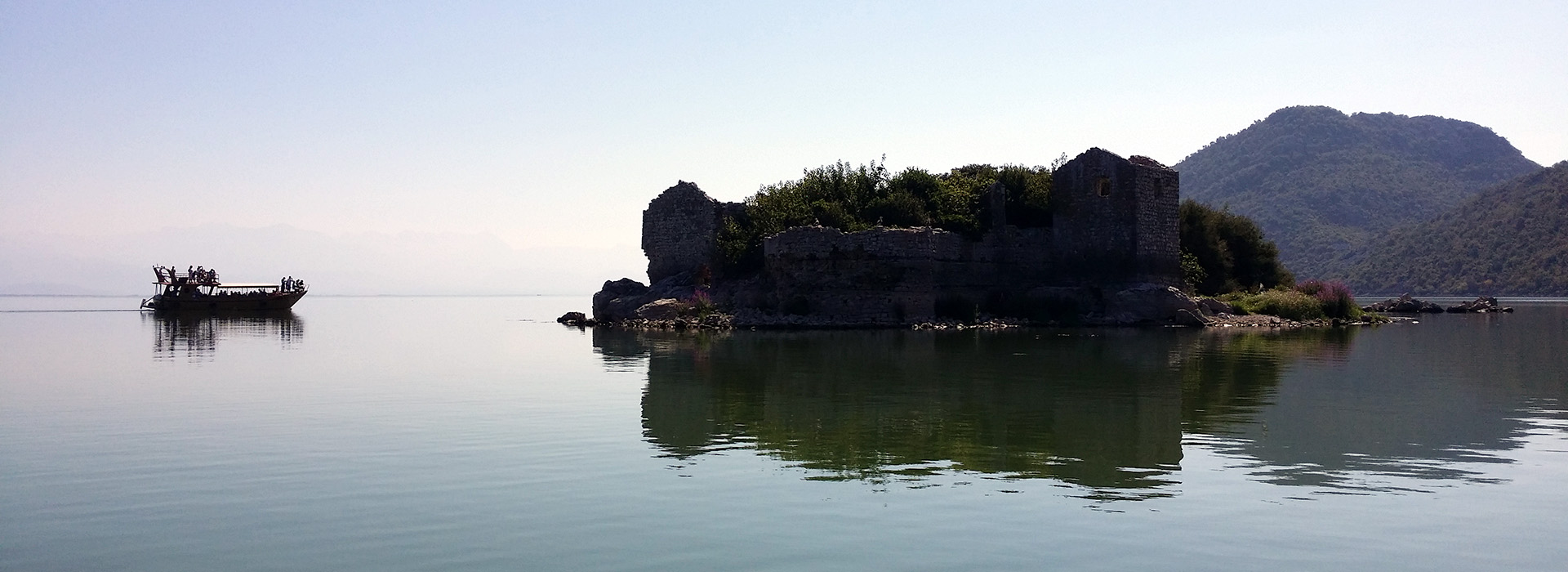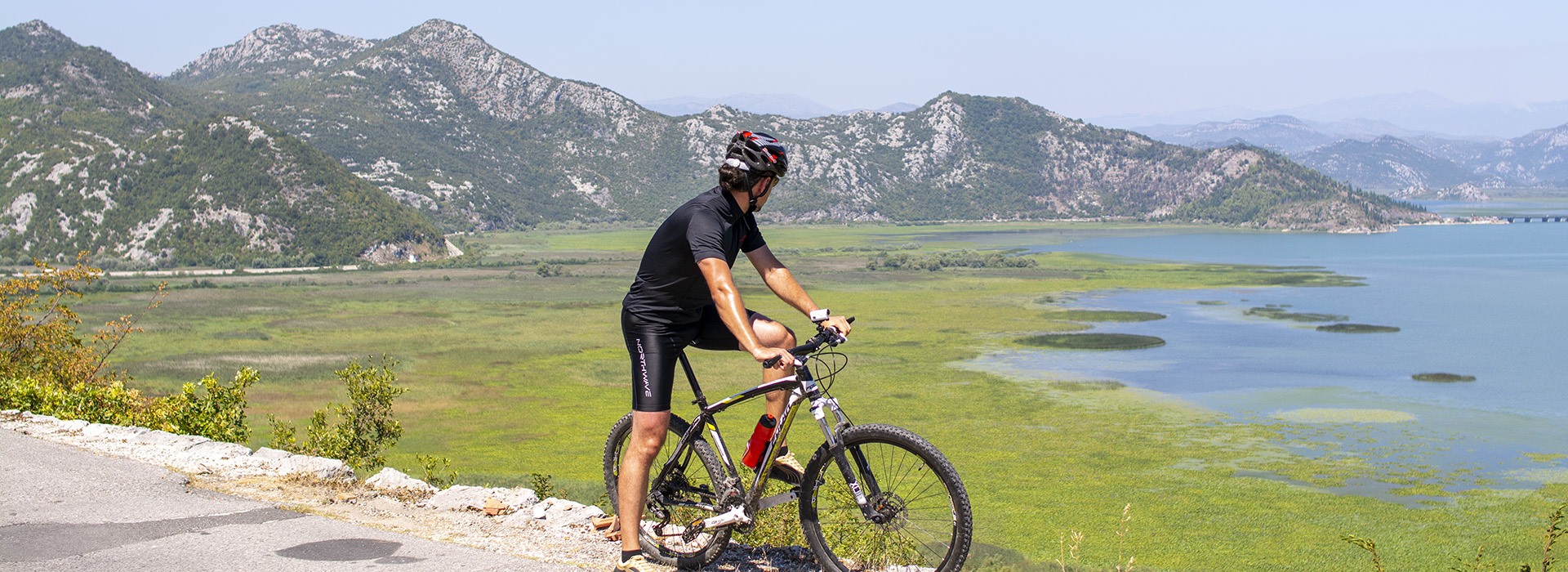
Cycling in the heart of the Balkans
Bicycle holiday in Bosnia and Montenegro, from Sarajevo to Skadar Lake national park
8 days / 7 nights cycling guided holiday in Bosnia and Montenegro while staying in the accommodation of very great comfort, from 1630 EUR (bicycle rental included)
-
Enjoy cycling and we organise all luggage transfers, tasty food and comfortable lodging, mechanic and guide support, even beverages and snacks.
-
Meet Sarajevo - Jerusalem of Europe.
-
Cycle through unspoilt countryside, impressive canyons and timeless villages.
-
We stay in the finest accommodation available in the area. Enjoy comfort and delicious food after activities.
-
Enjoy our quality bicycles (or E-bikes) and do not worry about flat tires or mechanical problems while cycling in this remote part of Europe.
-
Travel in a small group. The maximum group size is 15 persons.
-
Have a safe and risk-free booking. We have adopted all our procedures to WTTC (World Travel & Tourism Council), UNWTO (World Tourism Organisation), and local protocols and standards. Our booking and cancellation policy is adapted to new conditions and maximally flexible so you can not lose your money

BLOG STORY
Read more on ACE Adventure blog
3 Things You Shouldn't Forget When Going on a Balkan Adventure Tour
Making the Most of Your Balkan Adventure Tour: 3 Key Tips to Keep in Mind
Cycling grade:
Moderate
Five Days of cycling with daily distances ranging from 50km to 70km, one day of Sarajevo sightseeing and 20km ride.
RECOMMENDATIONS FOR EXTENSION
An option to extend your holiday for additional days in Sarajevo, Podgorica or any other coastal town is possible. Please contact us for the options and conditions.
Please read and respect ACE Responsible Tourism Policy.
Before you come on this trip please carefully read Rules of Bicycling Safety.
Book with confidence and risk-free. Please read our new booking and cancellation policy
Itinerary
-
-
Meeting the group at the Sarajevo airport and transfer to Sarajevo. Meeting the tour leader and the group. After introductory briefing free time and dinner.
-
Meals Included: /
Activity Free time on arrival at accomodation.
-
-
-
Sarajevo guided tour, 2h30 (morning).
The streets of Baščaršija (old part of town) are full of shops... images and sounds of the eastern Bazaars. Shops where copper pots, trays, and other metal cutlery and dishes are made. Barbershops, wooden objects, tools, burek, earrings and jewellery, kebabs... streets full of people ... mosques ... and again shops with fabrics and tailoring materials, scarves, knife sharpeners, watches, mobile phones, cups and pots ... the low roofs of the workshops covered with red tiles, all make a maze of the old eastern bazaar. The main square of this part of the city - Sebilj is always full of pigeons and the people who feed them. In the middle of the square is a wooden fountain covered with a copper dome, which many consider a symbol of Baščaršija. It dates back to 1891 and represents a reconstruction of the fountain erected in 1754 and destroyed in a fire in 1852.
A walk-through Sarajevo is a walk through the history and cultures of various conquerors who temporarily governed this city. Thus, from the part of the city that is unmistakably the legacy of the Ottoman Empire, we move without noticeable borders to the part where the Austro-Hungarian Empire left its mark. There, everything is more similar to other cities of European culture: the Catholic Cathedral, the Orthodox Cathedral and walk through the wide pedestrian zones. A visit to the brewery, where Sarajevsko Beer is brewed, is also not a bad idea. Or you can walk along the quay of the river Miljatska, buy some delicious ice cream, or have the famous "dest upola s lukom" - Sarajevo's street food speciality – minced beef, finger-shaped, in half a bun with onions.
There is something else you must not miss - the place where Gavrilo Princip, a member of the Young Bosnia movement that fought to overthrow the Austro-Hungarian government and join Yugoslavia, assassinated the Austro-Hungarian Prince Ferdinand. The event triggered the beginning of the First World War.
Afternoon cycling to Vrelo Bosne, the spring of the Bosna River -
Meals Included: Breakfast, Lunch, Dinner
Activity Cycling distance 20km on flat terrain
-
-
-
Transfer to Pale (40min, 25km). Cycle from Pale to Goražde through amazing mountain scenery of Jahorina. Mostly through deciduous forests, mountain farm lands and villages. Cycling on small unpaved road in the wilderness of Prača canyon.
-
Meals Included: Breakfast
Activity Total cycling distance – 71km, accummulated ascent 700m, descent 1.200m.
-
-
-
Leaving Goražde cycle following a scenic gorge of the spectacular Drina river. We will pass through a few smaller towns such as Ustikolina and Brod. After approx. 40km we will leave the Drina river and turn south-west toward Durmitor Massif in Montenegro. After crossing the border at Scepan Polje we will soon finish our cycling day before the road enters the Piva Canyon and starts to climb at an elevation of 1000m while enjoying marvelous view of one of the deepest canyons in the Europe. Transfer 40km to the ethno village Izlazak, Rudinice village, where the group stays overnight. The enchanting Ethno Village Izlazak is located on top of the hill amidst the clouds overlooking the emerald waters of the spectacular Komarnica Lake.
-
Meals Included: Breakfast, Dinner
Activity Total cycling distance – 67km, accummulated ascent 950m, descent 680m.
-
-
-
Back on the bicycles. We start the day with an ascent from Izlazak to gain 200m elevation. Cycling through alpine scenery – about 10km of undulated terrain before long descent towards Niksic town. From Niksic we ride to the village of Bogetići where we will stay overnight. A short bus ride on the narrow mountain road will take us to Ostrog monastery. Set before the imposing backdrop of sheer vertical walls, the whitewashed walls of the upper monastery makes an inspiring sight. The relics of St Basil lie in the monastery, reverentially housed in a sepulchral sanctuary that is linked to another chapel by series of caves and passages. The walls are crammed with gifts and pleas from the pilgrims and the entire atmosphere of the monastery is exceptionally piety.
From the monastery, we ride to Bogetići village where we stay overnight in Aparthotel Koliba. -
Meals Included: Breakfast, Dinner
Activity Total cycling distance – 58km, accummulated ascent 590m, descent 1.150m.
-
-
-
Cycle on the slopes of Prekornica Mt following the direction of the Zeta river valley. We slowly descend from 750m elevations where the monastery is located to the endpoint in Podgorica, at 20m elevation. Along the way, we pass through Danilovgrad town where stop for a refreshment. The next two nights we will spend in 5 star hotel located at the heart of Podgorica.
-
Meals Included: Breakfast
Activity Total cycling distance – 65km, accummulated ascent 120m, descent 630m.
-
-
-
We left the most beautiful ride for the end. After 30 minutes long transfer we arrive in the small town of Virpazar at the bank of Skadar Lake from where we will start our bicycle trip. The lake is surrounded by limestone mountains that rise steeply from the lakeshores and make a fairytale scenery, especially in the morning when all is wrapped in a mystery of the haze. Skadar Lake is one of the largest bird reserves in Europe and is home to the Dalmatian pelican. Straight from the town centre waterways bordered by reed and water lily meadows lead through the lake.
From Virpazar we take a scenic road to Rijeka Crnojevica town. We cycle through typical Mediterranean sceneries followed by the sounds of crickets and smells of sage. Even though the town has slightly less than 200 inhabitants, Rijeka Crnojevica was the capital of Montenegro in the 15th century. There we will rest and have time for lunch before we continue our ride back to Podgorica. -
Meals Included: Breakfast, dinner
Activity Total cycling distance – 52km, accummulated ascent 820m, descent 780m.
-
-
-
Transfer to Podgorica airport (20km)
-
Meals Included: Breakfast
Activity Transfer
-
ACE keeps rights to change daily itineraries.
Tour Information
-
SARAJEVO
The city of Sarajevo was founded on the crossroads of East and West, of Roman Catholicism and Eastern Orthodoxy, of Christianity and Islam, of Austrian boulevards and Ottoman shops, of modern skyscrapers and European squares.
The transition from East to West is much more than a metaphor; in Sarajevo, it is literal, geographical process. From the Ottoman East with it’s magnificent mosques and Oriental architecture, through the Austrian Center with it’s proud churches and European architecture, to the modern West with it’s towering buildings and wide highways.
In this valley, an amazing alchemy of cultures and religions merges into a single one – yet, each keeps something of its character and is recognizable for what it is. Light from the same source passes through the stained glass windows of the Katedrala, illuminates the gem that is Begova Mosque, lights of the central chandeleir of the Church of the Lord’s Holy Transfiguration, and caresses the ancient Soloman’s Seal, the Star of David. Nevertheless, it is all one whole, which could hardly be modified in any way. Trying to understand Sarajevo is one of the nicer things one can do in this world.The valley of the Drina
The valley of the Drina is the principal traffic artery in the south-eastern region of Bosnia. Since old times it has been part of the important route going from the sea inland, (Dubrovnik – Trebinje – Gacko – Foča – the Drina valley). This route was particularly significant in Roman times and in the Middle Ages when it was used by Dubrovnik citizens travelling to these parts of Bosnia and further on to Serbia. (The Dubrovnik Road). At Goražde this road meets another one coming from Sarajevo and central Bosnia via the Jabuka Mountain pass down to the Drina valley and preceding on to Plevlje.
The Piva Region
The Piva Region is situated in the Northwest of Montenegro. Positioned in the middle of the Dumitor mountain range with Volujak and Maglić on one side and the breathtaking the Tara River canyon on the other. The natural beauties of the Piva river canyon and the manmade Piva Lake dominate in the heart of the region, which gave the name to the entire region. This all along with richness of wild life and cultural monuments make the Piva region a very attractive destination. The breathtaking Tara, Piva and Komarnica river canyons are places that must be visited, as well as the Susica and Vrbnica River and glacier lakes: Skrcko, Susicko, Trnovacko and two Stabanjska lakes. Despite being artificial, Piva Lake is the jewel of the region, stretching 45km. The dam that formed Piva Lake has a staggering height of 220 meters.
Municipality of Pluzine
Municipality of Pluzine is situated on the territory 852 km2. The landscape is formed by very high mountains of Durmitor,Vojnik,Golija,Volujak and Maglić. The landscape is closely related to a climate, which is continental, with warm and very pleasant summers with the highest temperature of 36°C, and cold snowy winters with the lowest temperature of -20°C. Village Rudinice is one of the oldest and most beautiful villages, known not only for famous hero Bajo Pivljanin, but also for its landscape, location and rich nature.
It is set in central part of Piva, on the Pluzine –Niksic road, 13 km from Pluzine and 44 km from Niksic. From the main road, there are three roads to village, the shortest is 2 km and the longest is 4 kmThe monastery of Ostrog
The monastery of Ostrog is placed against an almost vertical background, high up in the large rock of Ostroska Greda, from which a superb view of the Bjelopavlici Plain explodes. Ostrog Monastery is the most popular pilgrimage place in Montenegro. The Monastery was founded by Vasilije, the Metropolitan Bishop of Herzegovina in the 17th century. He died there in 1671 and some years later he was sainted and proclaimed a wonderworker. His body is enshrined in a reliquary kept in the cave-church dedicated to the Presentation of the Mother of God to the Temple. The present-day look was given to the Monastery in 1923 -1926, after a fire which had destroyed the major part of the complex. Fortunately, the two little cave-churches were spared and they make the essential value of the whole monument. The frescoes in the Church of the Presentation were done towards the end of the 17th century. The other church, dedicated to the Holy Cross, is placed within a cave on the upper level of the monastery and was painted by Master Radul, who successfully coped with the natural shapes of the cave and laid the frescoes immediately on the surface of the rock and the south wall. Around the church are the monastic residences, which together with the church building and the beautiful scenery make this monument an agreeable place to stay in.
The orthodox Monastery of Ostrog is the most frequent visited one on the Balkans. It is visited by believers from all parts of the world, either individually or in groups.
It represents the meeting place of all three confessions: the Orthodox, the Catholics and the Muslims, because it is believed that the enshrined body of Saint Vasilije Ostroski makes miracles work. According to the stories of pilgrims, by praying by his body, many have been cured and helped in lessening the difficulties in their lives.Skadar Lake
With the area ranging from 370 to 530 square kilometers, Skadar Lake is the biggest lake in the Balkans. Due to its geographic position and sub Mediterranean climate, it is one of the most important habitats of swamp birds in Europe, right after the river Danube delta. There are around 280 bird species on the lake, including the rare curly pelican, which became a trademark of the National Park. Southern hinterland of the lake (Crmnica) is famous for the best vine in Montenegro. Together with the lake carp, this will satisfy even the most demanding gourmands. The lake has numerous extraordinary beaches, particularly those in the village Murići, not less attractive than beaches on the coast…
-
During this holiday we stay in the finest accommodation available in the area. We start the holiday with the first two nights in 4 star hotel in Sarajevo, and we finish the trip with the last two nights in 5 star hotel in Podgorica. We will spend one night in 3 star hotel in Goražde, Aparthotel in Bogetići, and the cottages in Izlazak Ethno Village.
We pay special attention to the choice of food and all places where we have dinners included, have restaurants with great choices of local specialities. If you have some dietary restrictions we will be happy to adapt our menu to you. -
-
transfer from Sarajevo airport to the hotel. Regardless of your arrival time, a private transfer will be organized for you.
-
seven lodgings (two nights in 4* hotels, two nights in 5* hotel, one night in ethno village Izlazak, 3* hotel in Goražde, and Aparthotel in Bogetići)
-
seven breakfasts, four dinners, one lunch
-
transportation and luggage transfer during the tour
-
full guiding service and bicycle mechanic support
-
guided city tour of Sarajevo
-
snacks and refreshing drinks during the daily tours
-
use of 24 speed hybrid bicycles
-
van support during cycling tours
-
transfer from the hotel in Podgorica to Podgorica airport. Regardless of your flight time, a private transfer will be organized for you
The following services are included in the price:
The price is based on double room occupancy.
Single room supplement 220 Euros.
E-bike rental: 260 Euros
The tour is available from May to end of October
Bicycles
We provide 24 speed hybrid bicycles. They are designed for riding both on paved and not paved roads with 28" wheels. Every bicycle has handlebar bag with map case as well as water bottle. Bicycle bag can carry max 5kg-11lb weight. If you prefer you can bring your own saddle and have us install it on our bikes. All our bicycles are provided with platform pedals. If you are used to ride a bicycle with clipless pedals they are welcome to bring them and we will install them on our bicycle.
E-bikes are also available for this trip. Our E-bikes are Scott E-Sub Cross or similar.
-
-
-
Travel Information
For stay up to 90 days in the Republic of Montenegro, and Bosnia and Herzegovina tourists from EU, America, Australia, Canada, Japan do not require a visa. Croatia is from 2013 European Union member state. All distances are given in kilometers. 1 mi=1,61 km, 1km =0.62mi, 1ft=0.3m/ 1inch=2.54cm
Weather Information
Weather is difficult to forecast but, normally, you can expect a nice weather from April to November.
Montenegro has a Mediterranean climate, hot dry summers and autumns and relatively cold winters with heavy snowfall inland. There is a chance of sporadic rain in spring and autumn, though generally this is in the form of short showers. You can expect cool nights in the Durmitor Mountain and on higher altitudes it is possible to have light snowing in April, May, October, November.
The southern and western parts of oa Bosnia and Herzegovina have Mediterranean climate while inland areas and areas with high elevation experience short, cool summers and long, severe winters. Bosnia-Herzegovina’s climate is different for each province. Herzegovina and the southern area has a modified Mediterranean climate with an average annual precipitation of 600 to 800 mm while the central and northern area of Bosnia has a modified Pannoian or Alpine climate with an average annual precipitation of 1,500 to 2,500 mm. Average temperature ranges in Sarajevo are from -.5 degrees Celsius in January to 19.6 degrees Celsius in July.Packing suggestions
Casual seasonal clothing is recommended for most occasions. You may wish to bring a light sweater and some light jacket. Padded bicycle shorts and bicycle gloves are useful. Sport shoes/ sneakers would be fine for cycling tours as all our bicycles are provided with platform pedals (if you bringing with you clip-less pedals you should bring also adequate shoes). We strongly recommend that you wear bicycle helmet whilst cycling. We believe that there is no helmet like your own and we do not provide helmets locally. Like a good fitting pair of walking boots, helmets are a very personal item of equipment. It is also more hygienic to wear your own rather than one which has been used by someone else previously. We recommend to bring bicycle helmet, cycling sunglasses and some bicycle or walking rain gear. You should also bring some SP and anti-mosquitoes cream. Also bring a swimsuit for swimming opportunities on the trip (Skadar Lake).
Note: A cycling helmet could be bought locally for the price of 30EUR. Please order it in advance.General Information
Currency and Exchange
Local Currency: Montenegro use Euro as a local currency. In Bosnia and Herzegovina monetary unit is Bosnia and Herzegovina Marka (BAM). For 1 Euro you can get 1.9 BAM (current exchange rate).
Where to Exchange: Banks or ‘forex’ offices in main towns/cities. Most of change offices are open from 8am to 8pm
ATM Availability: Generally widespread but limited in more rural areas. You will find ATM in Sarajevo, Goražde, and Virpazar
Credit Card Acceptance: Accepted in major restaurants and hotels. The most widely excepted credit cards are VISA, closely followed by MasterCard.
Travellers Cheques: Travellers cheques can be exchanged for the local currency but only in some banks.
Banks are generally open from 08:00 to 19:00 on weekdays and from 08:00 to 15:00 on Saturdays.
In smaller towns it is useful to have enough cash.
Most of the shops are open from 9am to 9 pm and remain open through lunch.
Restaurants: The main meal is taken at lunch from 1pm to 3pm. Restaurants serve dinner in the evening from 8pm till 11pm.Electric Current
In Bosnia and Montenegro electric current is 220 volts, 50 HZ. To use American or British electrical appliances a plug adapter is necessary. Electric plug used in Bosnia and Montenegro is type C (the same one is in use in Croatia, Belgium, Egypt, Italy, Hungary, Luxemburg, Netherlands, Norway, Bulgaria, Romania, Switzerland, Turkey, Vietnam, etc.
Telephone
Telephone plug used in Bosnia and Montenegro is US RJ-11 phone plug
Telephoning Home
Most of the telephone cards (AT&T…) do not work here. You can telephone from Post Office and pay after the call. The most convenient way for telephoning home is to use your mobile phone. Note that telephoning from Bosnia and Montenegro will involve roaming charges, so please double-check with your mobile provider at home about the rates and conditions.
To make a direct international call, first dial 00 or + (code to access international line) then the country code, the area code and local number. The country code for Austria is 43, Australia is 61, Norway 47, Great Britain is 44, USA and Canada 1, France 33, Germany 49…. To make a national call just dial area code and local telephone number.
ACE Emergency phone (24h available) +381 (0)64 24 76 311.
Important phone numbers in
in Bosnia and Herzegovina: 122 for Police, 123 for Fire Department and 124 for Emergency Medical Care, Help on the road 1282/ 1285/ 1288, Emergency number 112
in Montenegro: 122 for Police, 123 for Fire Department and 124 for Emergency Medical Care, Help on the road 19807Language
In old Yugoslavia Serbo-Croatian, also called Serbo-Croat, Serbo-Croat-Bosnian was a South Slavic language and the primary language of Serbia, Croatia, Bosnia and Herzegovina, and Montenegro. It is a pluricentric language with four mutually intelligible standard varieties. Since the break up of Yugoslavia every new state defined its own language and now Montenegrin is official language in Montenegro, Serbian in Serbia, Bosnian in Bosnia and Herzegovina and Croatian in Croatia. However, all those languages are the same with difference in dialects.In old Yugoslavia Serbo-Croatian, also called Serbo-Croat, Serbo-Croat-Bosnian was a South Slavic language and the primary language of Serbia, Croatia, Bosnia and Herzegovina, and Montenegro. It is a pluricentric language with four mutually intelligible standard varieties. Since the break up of Yugoslavia every new state defined its own language and now Montenegrin is official language in Montenegro, Serbian in Serbia, Bosnian in Bosnia and Herzegovina and Croatian in Croatia. However, all those languages are the same with difference in dialects.
INSURANCE
Travel insurance is highly recommended for all clients whilst on a tour organized by ACE. Clients together with their personal property including baggage are at all times solely at their own risk. Clients are wholly responsible for arranging their own insurance. Clients are responsible for ensuring that they are in possession of private Travel Insurance with protection for the full duration of the tour in respect of at least medical expenses, injury, death, repatriation, cancellation and curtailment, with adequate cover. Clients making their own arrangements should ensure that there is no exclusion clauses limiting protection for the type of activities included in their tour. Clients should satisfy themselves that any travel insurance is what they require and should arrange supplementary insurance if need be.
Responsible Travel
Before you come on the tour please read and respect ACE Responsible Tourism Policy
Personal Expenses
MEAL PLAN
Meals other than those included in the itinerary are paid for separately by traveler. Examples of some costs are provided below:
-
Coffee/ Tea - 0.8 Euro
-
Soft drink - 1 Euro
-
Bottle of beer - 1-2 Euro
-
Bottle of wine - 5-15 Euro
-
Two course meal - 8-10 Euro
-
Three course meal - 12-15 Euro
Local fares in small towns
Tipping
Although entirely voluntary, tipping is a recognized part of life in this part of the world. Gratuities for the staff of the ACE Adventure is discretionally but always appreciated by the staff and we will be happy to provide guidelines.
-
-
Photos
Dates & Prices
Date Start
Date End
Duration
Availability
Price








